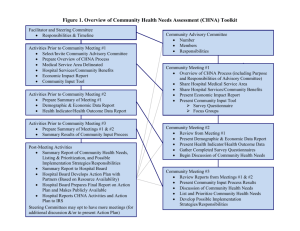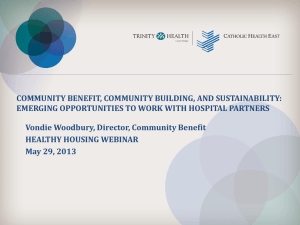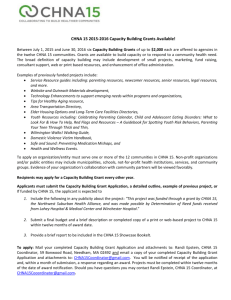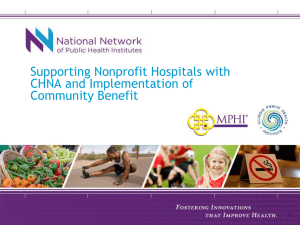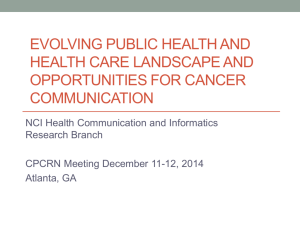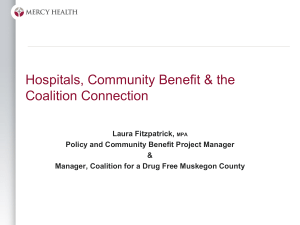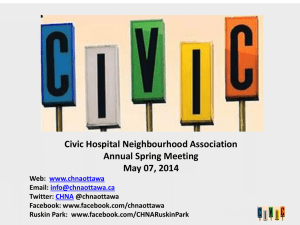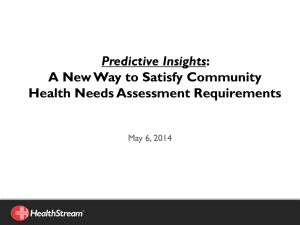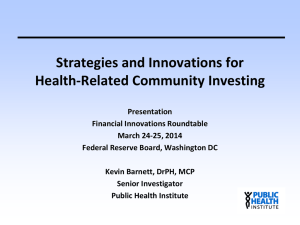IRS Releases Guidance on Community Health Needs Assessment Requirements for Charitable Hospitals
advertisement
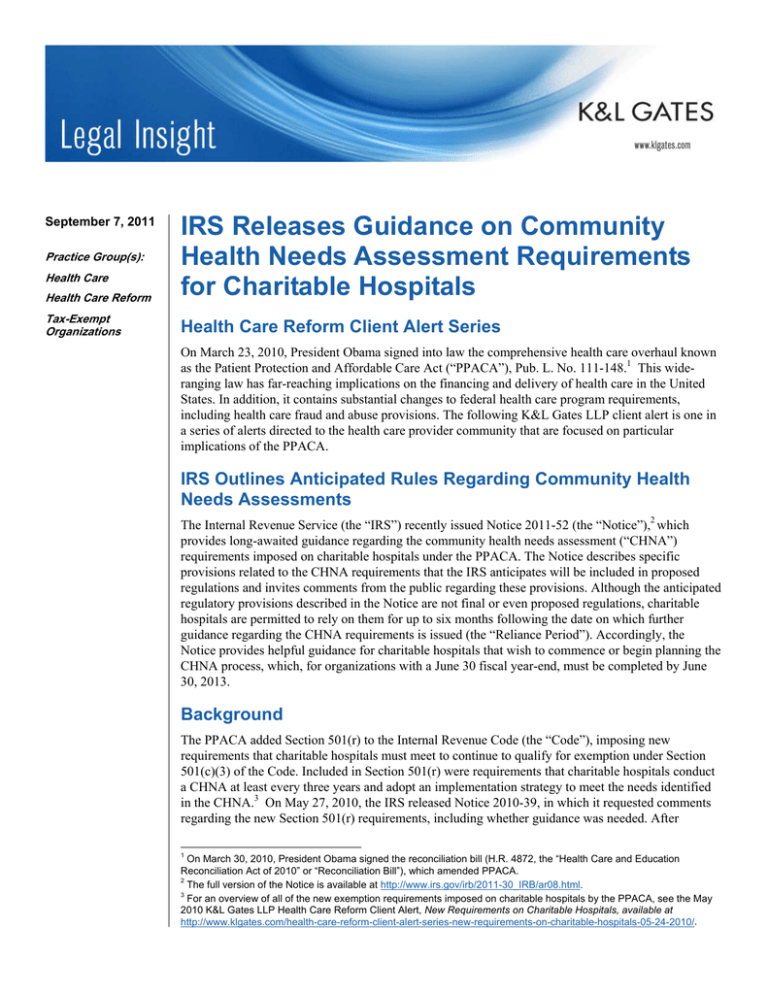
Health Care Reform IRS Releases Guidance on Community Health Needs Assessment Requirements for Charitable Hospitals Tax-Exempt Organizations Health Care Reform Client Alert Series September 7, 2011 Practice Group(s): Health Care On March 23, 2010, President Obama signed into law the comprehensive health care overhaul known as the Patient Protection and Affordable Care Act (“PPACA”), Pub. L. No. 111-148.1 This wideranging law has far-reaching implications on the financing and delivery of health care in the United States. In addition, it contains substantial changes to federal health care program requirements, including health care fraud and abuse provisions. The following K&L Gates LLP client alert is one in a series of alerts directed to the health care provider community that are focused on particular implications of the PPACA. IRS Outlines Anticipated Rules Regarding Community Health Needs Assessments The Internal Revenue Service (the “IRS”) recently issued Notice 2011-52 (the “Notice”),2 which provides long-awaited guidance regarding the community health needs assessment (“CHNA”) requirements imposed on charitable hospitals under the PPACA. The Notice describes specific provisions related to the CHNA requirements that the IRS anticipates will be included in proposed regulations and invites comments from the public regarding these provisions. Although the anticipated regulatory provisions described in the Notice are not final or even proposed regulations, charitable hospitals are permitted to rely on them for up to six months following the date on which further guidance regarding the CHNA requirements is issued (the “Reliance Period”). Accordingly, the Notice provides helpful guidance for charitable hospitals that wish to commence or begin planning the CHNA process, which, for organizations with a June 30 fiscal year-end, must be completed by June 30, 2013. Background The PPACA added Section 501(r) to the Internal Revenue Code (the “Code”), imposing new requirements that charitable hospitals must meet to continue to qualify for exemption under Section 501(c)(3) of the Code. Included in Section 501(r) were requirements that charitable hospitals conduct a CHNA at least every three years and adopt an implementation strategy to meet the needs identified in the CHNA.3 On May 27, 2010, the IRS released Notice 2010-39, in which it requested comments regarding the new Section 501(r) requirements, including whether guidance was needed. After 1 On March 30, 2010, President Obama signed the reconciliation bill (H.R. 4872, the “Health Care and Education Reconciliation Act of 2010” or “Reconciliation Bill”), which amended PPACA. 2 The full version of the Notice is available at http://www.irs.gov/irb/2011-30_IRB/ar08.html. 3 For an overview of all of the new exemption requirements imposed on charitable hospitals by the PPACA, see the May 2010 K&L Gates LLP Health Care Reform Client Alert, New Requirements on Charitable Hospitals, available at http://www.klgates.com/health-care-reform-client-alert-series-new-requirements-on-charitable-hospitals-05-24-2010/. IRS Releases Guidance on Community Health Needs Assessment Requirements for Charitable Hospitals reviewing numerous comments from the public requesting guidance on the CHNA requirements of Section 501(r), the IRS issued Notice 2011-52, the provisions of which are summarized below. Applicability of CHNA Requirements to “Hospital Organizations” The CHNA requirements apply to “hospital organizations,” which are defined in Section 501(r) to include (1) organizations that operate one or more state-licensed hospital facilities, and (2) any other organization that the Treasury Secretary determines is providing hospital care as its principal function or basis for exemption. The Notice states that the IRS is deferring guidance on which organizations fall into the second category, effectively leaving only organizations operating state-licensed hospital facilities currently subject to the CHNA requirements. The Notice, however, did clarify that hospital organizations are expected to include 501(c)(3) organizations operating state-licensed hospital facilities through a disregarded entity or other entity treated as a partnership for federal income tax purposes, such as a limited liability company or other joint venture. How and When to Conduct a CHNA Under Section 501(r), a hospital organization is required to conduct a CHNA for each of its hospital facilities once every three taxable years. The CHNA must take into account input from persons representing the community served by the hospital facility and must be made widely available to the public. The CHNA requirements are effective for taxable years beginning after March 23, 2012. As a result, a hospital organization with a June 30 fiscal year end must conduct an initial CHNA for each of its hospital facilities by June 30, 2013, either during the fiscal year ending June 30, 2013 or during either of the two previous fiscal years. The Notice provides the following guidance on how to conduct a CHNA in compliance with Section 501(r). Determining the Community Served A CHNA must identify and assess the health needs of the community served by the hospital facility. Although the Notice suggests that geographic location should be the primary basis for defining the community served, it provides that the organization may also take into account the target populations served by the facility (e.g., children, women, or the aged) and/or the facility’s principal functions (e.g., specialty area or targeted disease). A hospital organization, however, will not be permitted to define the community served in a way that would effectively circumvent the CHNA requirements (e.g., by excluding medically underserved populations, low-income persons, minority groups, or those with chronic disease needs). Persons Representing the Community Served Section 501(r) provides that a CHNA must take into account input from persons who represent the broad interests of the community served by the hospital facility, including individuals with special knowledge of or expertise in public health. Under the Notice, the persons consulted must also include (1) government agencies with current information relevant to the health needs of the community and (2) representatives or members of medically underserved, low-income, and minority populations, and populations with chronic disease needs, in the community. In addition, a hospital organization may seek input from other individuals and organizations located in or serving the hospital facility’s defined community (e.g., health care consumer advocates, academic experts, private businesses, health insurance and managed care organizations, etc.). 2 IRS Releases Guidance on Community Health Needs Assessment Requirements for Charitable Hospitals Required Documentation The Notice provides that a hospital organization will be required to separately document the CHNA for each of its hospital facilities in a written report that includes the following information: a description of the community served by the facility and how the community was determined; a description of the process and methods used to conduct the CHNA; the identity of any and all organizations with which the organization collaborated and third parties that it engaged to assist with the CHNA; a description of how the organization considered the input of persons representing the community (e.g., through meetings, focus groups, interviews, etc.), who those persons are, and their qualifications; a prioritized description of all of the community needs identified by the CHNA and an explanation of the process and criteria used in prioritizing such needs; and a description of the existing health care facilities and other resources within the community available to meet the needs identified through the CHNA. Making a CHNA Widely Available to the Public The Notice provides that a CHNA will be considered to be “conducted” in the taxable year that the written report of the CHNA findings is made widely available to the public. The Notice also indicates that the IRS intends to pattern its rules for making a CHNA “widely available to the public” after the rules currently in effect for Forms 990. Accordingly, an organization would make a facility’s written report widely available by posting on its website either (1) the report itself, in a readily accessible format, or (2) a link to another organization’s website, along with instructions for accessing the report on that website. The Notice clarifies that an organization must post the CHNA for each facility until the date on which its subsequent CHNA for that facility is posted. How and When to Adopt an Implementation Strategy Section 501(r) requires a hospital organization to adopt an implementation strategy to meet the needs identified through each CHNA. The Notice defines an “implementation strategy” as a written plan that addresses each of the needs identified in a CHNA by either (1) describing how the facility plans to meet the health need, or (2) identifying the health need as one that the facility does not intend to meet and explaining why the facility does not intend to meet it. A hospital organization may develop an implementation strategy in collaboration with other organizations, which must be identified in the implementation strategy. As with the CHNA, a hospital organization that operates multiple hospital facilities must have a separate written implementation strategy for each of its facilities. Under the Notice, an implementation strategy is considered to be “adopted” on the date the strategy is approved by the organization’s board of directors or by a committee of the board or other parties legally authorized by the board to act on its behalf. Further, the formal adoption of the implementation strategy must occur by the end of the same taxable year in which the written report of the CHNA findings was made available to the public. For hospital organizations with a June 30 fiscal year end, that effectively means that the organization must complete and appropriately post its first CHNA no later than its fiscal year ending June 30, 2013, and formally adopt a related implementation strategy by the end of the same tax year. This final requirement may come as a surprise to many charitable 3 IRS Releases Guidance on Community Health Needs Assessment Requirements for Charitable Hospitals hospitals, considering Section 501(r) contains no deadline for the adoption of the implementation strategy. Form 990 Reporting Requirements The PPACA imposed several new reporting requirements on charitable hospitals that are required to file a Form 990. Among them is a requirement to disclose in the Form 990 certain information regarding the organization’s compliance with the CHNA requirements. The IRS has already updated Schedule H of the Form 990 to address some of the required disclosures, and will continue to modify Schedule H to more closely mirror the new (and any future) CHNA guidance. Notably, the Notice provides that hospital organizations will be required to attach to the Form 990 the most recently adopted implementation strategy for each of their hospital facilities. Because such a requirement would make the implementation strategy a public document, hospital organizations would be advised to exercise caution with regard to any confidential or proprietary information that may be included in the strategy. The IRS announced in the Notice, however, that because the CHNA requirements are not effective until taxable years beginning after March 23, 2012, organizations will not be required to complete the portions of Schedule H that relate to the CHNA for any taxable year beginning on or before that date. Accordingly, an organization with a June 30 fiscal year-end will not be required to complete the portions of Schedule H that relate to the CHNA until it files the Form 990 for the fiscal year ending June 30, 2013 (assuming that the organization did not elect to complete the CHNA requirements in a previous tax year).4 Implications The Notice reveals how the IRS intends to interpret and apply the CHNA requirements of Section 501(r) and serves as welcome guidance for charitable hospitals that wish to start planning and/or conducting their CHNAs, which is a substantial undertaking. By applying the guidelines in the Notice and taking advantage of the Reliance Period, a charitable hospital theoretically could complete the CHNA process by its June 30, 2012 fiscal year-end (a year ahead of the June 30, 2013 deadline) and be in compliance with the CHNA requirements of Section 501(r) until its June 30, 2015 fiscal year. In applying the provisions of the Notice, however, it is important to consider the following: Under the guidance currently in effect, organizations seeking to rely on the Notice to comply with the CHNA requirements of Section 501(r) must not only craft their CHNAs and implementation strategies in compliance with the provisions set forth in the Notice, but they must also complete the entire process (i.e., make the CHNA report widely available to the public and adopt the implementation strategy) within a single tax year and before the end of the Reliance Period, a date that is currently unknown.5 The proposed and/or final regulations, once released, may change the CHNA requirements and be more detailed and less flexible than the provisions described in the Notice (there are several 4 Presumably, the grace period for Form 990 reporting would not apply to an organization that wishes to complete the CHNA process in the 2011-2012 tax year, as such an organization would be required to, among other things, attach to its Form 990 the implementation strategy adopted during such tax year. 5 For example, if the IRS were to issue additional CHNA guidance on March 1, 2012, the Reliance Period would end on September 1, 2012. An organization with a June 30 fiscal year-end that conducted its CHNA during the 2011-2012 fiscal year would therefore need to make the CHNA report widely available and adopt its implementation strategy by June 30, 2012. If the IRS were to issue the new CHNA guidance on November 1, 2011, however, an organization relying on the Notice would be required to complete the entire CHNA process by May 1, 2012. 4 IRS Releases Guidance on Community Health Needs Assessment Requirements for Charitable Hospitals subjects on which the IRS completely deferred guidance), so charitable hospitals that are unable to complete the entire CHNA process within the Reliance Period may encounter difficulties. Circular 230 Notice: To ensure compliance with requirements imposed by the IRS, we inform you that any U.S. federal tax advice contained in this communication (including any attachments) is not intended or written to be used, and cannot be used, for the purpose of (i) avoiding penalties under the Internal Revenue Code of 1986, as amended ir (ii) promoting, marketing or recommending to another party any transaction or matter addressed within. Authors: Cordelia A. Glenn Grabiak Cordelia.grabiak@klgates.com +1.412.355.6701 Sara Bates Sara.bates@klgates.com +1.412.355.8255 5
